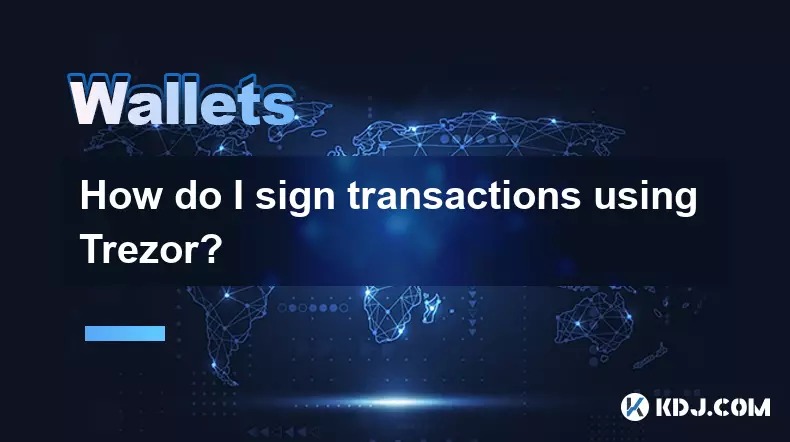-
 bitcoin
bitcoin $109667.069529 USD
-3.03% -
 ethereum
ethereum $3936.685804 USD
-4.07% -
 tether
tether $1.000493 USD
0.01% -
 xrp
xrp $2.771823 USD
-4.74% -
 bnb
bnb $957.805027 USD
-5.34% -
 solana
solana $196.735100 USD
-6.68% -
 usd-coin
usd-coin $0.999727 USD
-0.01% -
 dogecoin
dogecoin $0.227355 USD
-5.12% -
 tron
tron $0.335205 USD
-0.81% -
 cardano
cardano $0.779256 USD
-3.59% -
 ethena-usde
ethena-usde $0.999900 USD
-0.06% -
 hyperliquid
hyperliquid $42.492095 USD
-6.61% -
 chainlink
chainlink $20.501853 USD
-4.34% -
 avalanche
avalanche $28.952606 USD
-11.21% -
 stellar
stellar $0.356038 USD
-3.93%
How do I sign transactions using Trezor?
Trezor keeps your crypto safe by signing transactions offline, requiring physical approval and never exposing private keys.
Sep 26, 2025 at 08:18 am

Understanding Transaction Signing with Trezor
Trezor hardware wallets provide a secure method for managing cryptocurrency assets by keeping private keys offline. When it comes to signing transactions, the process ensures that funds can only be moved with explicit user approval through physical interaction with the device.
1. Connect your Trezor device to your computer using the provided USB cable.2. Unlock your device by entering your PIN directly on the Trezor screen to prevent keyloggers from capturing it.3. Open the Trezor Suite application or any compatible wallet interface such as Electrum or MyEtherWallet.4. Initiate a transaction within the wallet interface by specifying the recipient address, amount, and network fee.5. Confirm all transaction details on your Trezor’s display screen before approving it with a button press.
Security Measures During Transaction Signing
The integrity of each transaction depends heavily on the security protocols enforced during the signing phase. Trezor's design prevents exposure of sensitive data even when connected to potentially compromised systems.
- The private key never leaves the Trezor device; all cryptographic operations occur internally.
- Every outgoing transaction must be manually confirmed on the device’s screen, which acts as a firewall against unauthorized transfers.
- Phishing protection is built into newer models, verifying recipient addresses directly on the device to avoid malicious address substitution.
- Firmware updates are signed and verified to ensure authenticity and protect against supply chain attacks.
- Users should always check the device's screen for discrepancies in amounts or addresses before finalizing approval.
Using Third-Party Wallets with Trezor
Trezor supports integration with various third-party platforms, expanding its utility across different blockchains and services.
- In Electrum for Bitcoin, select 'Use Hardware Device' during wallet setup and follow prompts to connect Trezor.
- For Ethereum-based tokens, access MyEtherWallet and choose Trezor as the connection method via WebUSB or U2F.
- Ensure the website uses HTTPS and displays the official Trezor logo when connecting the device.
- Some decentralized exchanges allow direct wallet linking through WalletConnect, where Trezor serves as the signing backend.
- Always disconnect the device after completing transactions to minimize exposure to potential vulnerabilities.
Recovery and Backup Procedures
Maintaining access to funds requires proper handling of recovery phrases and understanding how they relate to transaction capabilities.
- During initial setup, write down the 12 or 24-word recovery seed exactly as displayed—never store it digitally.
- This seed allows restoration of wallet access on any Trezor device if the original is lost or damaged.
- If restoring, use the same passphrase (if previously set) to regain control over associated accounts.
- Avoid using the recovery seed unless absolutely necessary, as exposure increases risk.
- Test the recovery process with a small amount before relying on it in an emergency scenario.
Frequently Asked Questions
Can I sign transactions without an internet connection?Yes, the Trezor device itself does not require internet access. However, the companion software (like Trezor Suite) needs connectivity to broadcast transactions to the blockchain network.
What happens if I lose my Trezor but have the recovery seed?You can restore your wallet on another Trezor device or compatible hardware/software wallet using the recovery phrase, ensuring continued access to your funds.
Is it safe to use Trezor with public computers?It is not recommended. Public machines may contain malware that could intercept data or trick you into signing malicious transactions, even though the private key remains protected.
How do I verify that the transaction details shown on my computer match what’s on the Trezor screen?Always compare the recipient address, amount, and fees on both screens. The Trezor display is the authoritative source—approve only if both match exactly.
Disclaimer:info@kdj.com
The information provided is not trading advice. kdj.com does not assume any responsibility for any investments made based on the information provided in this article. Cryptocurrencies are highly volatile and it is highly recommended that you invest with caution after thorough research!
If you believe that the content used on this website infringes your copyright, please contact us immediately (info@kdj.com) and we will delete it promptly.
- Big Rocking Horse, Coin, and Ice Cream: An Aussie Icon's Sweet Ride
- 2025-09-26 10:45:16
- Pi Network, Price Forecast, and the Meme Market: A New York Minute
- 2025-09-26 10:25:14
- AIXA Miner: Revolutionizing Bitcoin Mining with Cloud Solutions
- 2025-09-26 10:45:16
- Mid-Cap Altcoins: Crypto Buys with Breakout Potential
- 2025-09-26 10:50:01
- BullZilla Presale: Riding the Crypto Wave in September 2025
- 2025-09-26 10:50:01
- Litecoin ETF Buzz, XRP Breakout Dreams, and BlockDAG's Deployment: Crypto's Wild West in '25
- 2025-09-26 10:50:01
Related knowledge

How do I view smart contract interaction history in Coinbase Wallet?
Sep 24,2025 at 01:36am
Accessing Smart Contract Interaction History in Coinbase Wallet1. Open the Coinbase Wallet application on your mobile device and log in using your cre...

How do I use the token swap feature in Coinbase Wallet?
Sep 24,2025 at 05:00pm
Understanding Token Swaps in Coinbase Wallet1. The token swap feature in Coinbase Wallet enables users to exchange one cryptocurrency for another dire...

How do I participate in governance voting in Coinbase Wallet?
Sep 25,2025 at 01:55pm
Understanding Market Volatility in the Crypto Space1. Cryptocurrency markets are known for their extreme price fluctuations, often driven by sentiment...

How do I set up a custom RPC node in Coinbase Wallet?
Sep 24,2025 at 12:00pm
Understanding Custom RPC Nodes in Coinbase Wallet1. A custom RPC (Remote Procedure Call) node allows users to connect their Coinbase Wallet to a block...

How do I manage multiple assets in Coinbase Wallet?
Sep 23,2025 at 10:00am
Understanding Multi-Asset Support in Coinbase Wallet1. Coinbase Wallet allows users to store a wide variety of digital assets beyond just Bitcoin and ...

How do I connect Coinbase Wallet to a hardware wallet?
Sep 26,2025 at 02:54am
Connecting Coinbase Wallet to a Hardware Device1. Open the Coinbase Wallet app on your mobile device and ensure it is updated to the latest version. N...

How do I view smart contract interaction history in Coinbase Wallet?
Sep 24,2025 at 01:36am
Accessing Smart Contract Interaction History in Coinbase Wallet1. Open the Coinbase Wallet application on your mobile device and log in using your cre...

How do I use the token swap feature in Coinbase Wallet?
Sep 24,2025 at 05:00pm
Understanding Token Swaps in Coinbase Wallet1. The token swap feature in Coinbase Wallet enables users to exchange one cryptocurrency for another dire...

How do I participate in governance voting in Coinbase Wallet?
Sep 25,2025 at 01:55pm
Understanding Market Volatility in the Crypto Space1. Cryptocurrency markets are known for their extreme price fluctuations, often driven by sentiment...

How do I set up a custom RPC node in Coinbase Wallet?
Sep 24,2025 at 12:00pm
Understanding Custom RPC Nodes in Coinbase Wallet1. A custom RPC (Remote Procedure Call) node allows users to connect their Coinbase Wallet to a block...

How do I manage multiple assets in Coinbase Wallet?
Sep 23,2025 at 10:00am
Understanding Multi-Asset Support in Coinbase Wallet1. Coinbase Wallet allows users to store a wide variety of digital assets beyond just Bitcoin and ...

How do I connect Coinbase Wallet to a hardware wallet?
Sep 26,2025 at 02:54am
Connecting Coinbase Wallet to a Hardware Device1. Open the Coinbase Wallet app on your mobile device and ensure it is updated to the latest version. N...
See all articles










































































